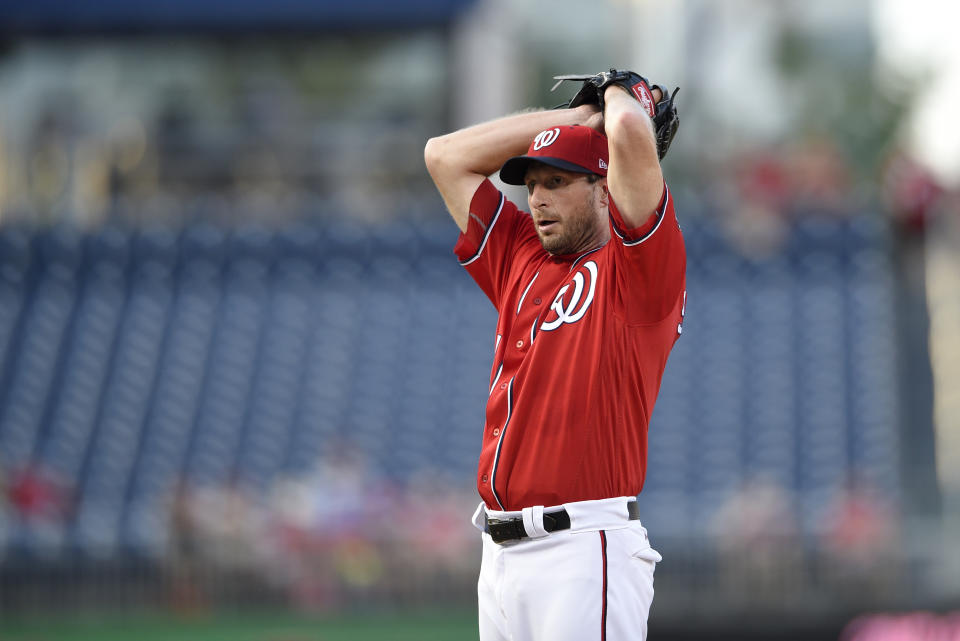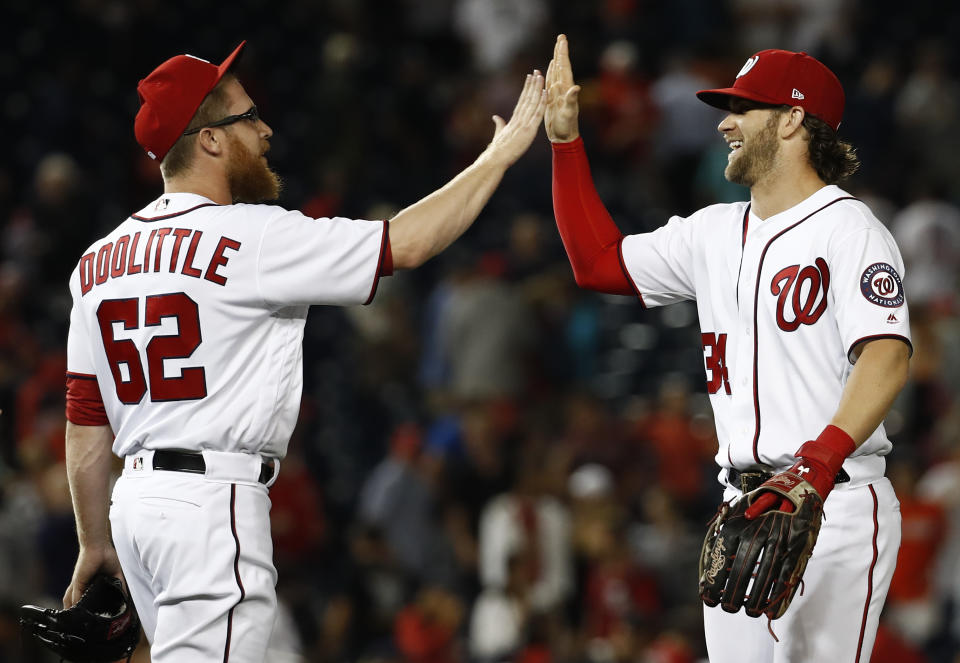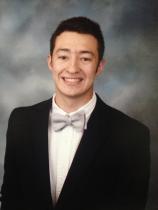Can the Nationals piece together their fractured roster and finally win a playoff series?
The third-best team in baseball doesn’t look the part right now. It’s not even close.
Held together by duct tape and glue, the Washington Nationals look like a shell of themselves when you glance at the active roster. Yet they chug on sans Bryce Harper, sans Trea Turner, sans Jayson Werth, sans… well, you get the point. In fact, through Sunday, they’ve amassed a better winning percentage after the All-Star break (26-15, .634) than before (52-36, .591). The Nationals have the NL East all but wrapped up.
That’s incredible when you consider the lineup shuffling they’ve been forced into because of injury. So far this season, they’ve played 13 outfielders, 11 starting pitchers and 15 relievers. The last time they played the same eight position players in the same batting order for back-to-back games? Go back almost a full month to Aug. 6 and 7. On both Friday and Saturday, they played just one of their Opening Day starters.
As we get closer to September and the postseason expectations creep in for Washington, there’s another big question: Who will they bring along in the postseason?
For the Nationals, that’s a trickier question than for most teams — and it might come with more scrutiny, as they try to avoid another postseason disappointment. Since 2012, just one team, the Dodgers, have won more regular season games. Yet the Nationals have never won a playoff series, losing in the NLDS in 2012, ’14 and ’16 and missing the playoffs in ’13 and ’15.
But this year’s team has just as much talent as any in the majors and certainly more than previous iterations representing the nation’s capital. Werth and ace Max Scherzer (who was sidelined with a stiff neck) came back from injury Monday and Turner is expected back later in the week. And though Harper hasn’t started baseball activities, he’s expected to return for the start of the postseason if he has no setbacks. And the Nationals — despite the injuries — took two of three in Houston against the Astros; took two of three in Los Angeles against the Dodgers; and won the season series against the Cubs.
Washington, D.C. hasn’t had a champion since 1992. It hasn’t even had a conference championship appearance since 1998. The Nationals are perhaps the most legitimate contender to break at least one of those streaks and exorcise their own demons. In order to do that, they have to find a roster that takes advantage of their impressive organizational depth while setting up the team’s stars for success.
Here’s how they could do it:
Starting lineup:
Let’s assume, first and foremost, that the Nationals go with the following starting lineup. This, of course, assumes everyone who is currently healthy remains that way and the full healing of everyone who isn’t:
1. Trea Turner, SS
2. Jayson Werth, LF
3. Bryce Harper, RF
4. Ryan Zimmerman, 1B
5. Daniel Murphy, 2B
6. Anthony Rendon, 3B
7. Matt Wieters, C
8. Michael A. Taylor, CF
Bench locks:
Just three bench players are absolute locks: 1B/OF Adam Lind, C Jose Lobaton and utility man Howie Kendrick.
Coming off a down year, Lind signed a modest one-year, $1 million deal in February. No one would have predicted him becoming one of baseball’s best bench assets, but that’s what he’s done. Lind is batting .304, has been a popular option in left field with Werth out and has given Zimmerman plenty of days off at first base, too. Most importantly for the postseason, though, he’s hitting .378 in 40 plate appearances as a pinch hitter through Sunday, rocking an OPS over 1.000.
Lobaton is a defensive specialist and an important clubhouse presence. Oh yeah, he also did this last postseason. And Kendrick is a seasoned vet and has been fantastic since coming over from Philadelphia, playing and batting all over. Lind, Lobaton and Kendrick bring us to 11 position players.

Bench question marks:
The next two or three spots could go to any of the following: infielders Wilmer Difo and Adrian Sanchez, catcher Pedro Severino and outfielders Brian Goodwin, Ryan Raburn, Andrew Stevenson and Alejandro De Aza. Yeah, there are a ton of outfielders to choose from. (Note: Shortstop Stephen Drew, who would be a strong candidate for a spot, was transferred to the 60-day DL, essentially ending his season.)
Difo, who has started with Turner out, is a curious case. His 2017 splits through Sunday are hands-down insane.
As a starter: .298/.345/.408
As a substitute: .154/.267/.154
As a pinch hitter: .067/.222/.067
Can Difo, a switch-hitter, be counted on when he’s arriving at the park not knowing if he’ll get at-bats? His hot stretch over the past two months should give him the confidence to do so, and his versatility and speed can make him an important late-game replacement candidate.
The next most-likely candidate is Goodwin, who is currently on the 10-day DL with a left groin strain. He was an everyday player for June, July and the first half of August, and he has committed just two errors all year. And with Taylor struggling with his bat since returning from the disabled list (.196/.268/.255), Goodwin — whose .811 OPS is fifth-best on the team — could even be a candidate to start once he comes back. With the roster expanding, both Taylor and Goodwin should have the opportunity to prove themselves ahead of the postseason.
Whether the Nationals go with 11 or 12 pitchers depends very much on who performs in September. Of the last eight World Series rosters, five have included 11 pitchers and three have had 12, so it wouldn’t be unprecedented for the Nationals to go either way. Given the staff’s injury history, 12 pitchers wouldn’t be out of the question, but given the starters’ ability to go deep in games, neither is 11. For what it’s worth, Washington had 11 pitchers on last year’s NLDS roster. Regardless, adding Difo and Goodwin to the mix brings the roster to 13.
Starting rotation:
In all likelihood, the Nationals will carry five starters, with four joining the rotation and one filling the long relief role:
Max Scherzer
Stephen Strasburg
Gio Gonzalez
Tanner Roark/Edwin Jackson
Jackson has been outstanding in his second go-round with the Nationals, while Roark has overcome first-half struggles to pitch to the tune of a 5-2 record, 3.31 ERA and .197 batting average against since the break. So the Nationals have some flexibility, and both guys have prior experience coming out of the bullpen. Both have pitched well enough in the past weeks to warrant a spot. Those five, combined with the starting lineup and a five-man bench, bring us to a roster of 18. And this is where things get interesting.

Bullpen locks:
Brandon Kintzler, Ryan Madson (who is on the 10-day DL) and Sean Doolittle have been solid in the seventh, eighth and ninth, respectively. If healthy, they’re all locks. That puts us at 21.
Matt Albers, like Lind, has been a low-cost pleasant surprise. He’s enjoying the best year of his career, posting a 1.76 ERA and 0.922 WHIP. If a starter can’t get the game to the sixth, Albers will likely be the person the Nationals use to bridge the gap between starter and Kintzler/Madson/Doolittle. Likewise, Oliver Perez is experiencing a renaissance year, posting the best WHIP (1.081), second-best FIP (3.13) and fourth-best ERA (3.14) of his career. He can be used as a situational arm — likely as a LOOGY (left-handed one-out guy, the best acronym in baseball) — and is also a lock. Lefties are hitting just .196 against him. That takes us to a roster of 23.
Bullpen question marks:
The final two spots are an intriguing race. Sammy Solis, Shawn Kelley, Matt Grace and Joe Blanton are currently rounding out the ‘pen. Solis, 29, looked to be a rising star last year, but he has struggled with health and consistency this year. Case in point: He pitched 3 2/3 scoreless innings between Aug. 13 and Aug. 18, only to give up a hit and two walks without recording an out on Aug. 19 against the Padres. Kelley has given up 11 home runs in 21.2 innings through Sunday. Grace has had a tough August. Through Sunday, Blanton had the worst ERA of his career (6.51) but has been better of late. It will simply be a numbers game at this point for that quartet.
Then there are the relievers who haven’t been with the team recently but are certainly candidates to return. Fireball lefty Enny Romero is the only guy who touches triple digits, and he has the stuff to be the closer of the future. He’s pitched well in all types of situations and is especially tough on righties (.237 batting average against). There are times when he’s looked dominant, blowing away guys with his heater. There are also times when he misses his location and gives up hard contact. Currently rehabbing at Triple-A Syracuse, Romero will have plenty of opportunities to stake a claim in September, and he should be part of this staff for the postseason.
The same might not be said for Koda Glover, who was putting together a strong case to be the full-time closer by the end of May: The 24-year-old righty had a 2.08 ERA and was seven-for-eight in save opportunities. But he blew up in June, giving up seven runs in two innings. His final outing before hitting the DL — a blown save in which he allowed two runs in 2/3 innings — came after he slipped in the shower and was subsequently dealing with back pain. Then came reports of rotator cuff inflammation, and Glover’s status is still very much shrouded in mystery. There’s just over a month until the playoffs start, and Glover isn’t pitching anywhere yet. The minor league regular seasons are over shortly after Labor Day. It’s a race against the clock — and he’s not currently winning.
Kept up to this point? Obviously a lot can and will change in September. Depending on who is healthy, who performs and how manager Dusty Baker feels about his bullpen will have major implications for the rest of the roster. Could a veteran bat like Ryan Raburn take away a bullpen spot? What about a youngster like Adrian Sanchez? Could Blanton continue his mid-summer rebound and solidify a spot? Could Romero or Glover make a return and take a spot? There are lots of possibilities, but if Romero can finish up his rehab assignment within the next couple of weeks without any setbacks, he should replace Grace as a middle-inning lefty. And while Blanton has postseason pedigree, that’s not as important following the additions of World Series champ Madson and playoff vet Doolittle.
Considering how good the starters and the bullpen (following the moves for Madson, Doolittle and Kintzler) have been, the final spot should go to adding another bat to the bench. The leading candidates would be Sanchez and Raburn. Sanchez got his major league career off to an inauspicious start, going one for his first 16. Since, though, he’s batting .400, including a blistering .429 in August. He can play all three middle infield positions. Raburn, though, has more power and is a career .282/.341./.483 hitter in the second half, the reason behind his “Second-Half Raburn” nickname. Raburn’s 10 games’ worth of postseason experience helps, too, and he should nab the final spot over the versatile but young Sanchez.
Projected playoff roster (starters in bold):
Catchers (2):
C Matt Wieters
C Jose Lobaton
Infielders (6):
1B Ryan Zimmerman
1B/OF Adam Lind
2B Daniel Murphy
3B Anthony Rendon
SS Trea Turner
SS/2B Wilmer Difo
Outfielders (5):
OF Bryce Harper
OF Michael A Taylor
OF Jayson Werth
OF Brian Goodwin
OF Ryan Raburn
Utility (1):
UTIL Howie Kendrick
Starting pitchers (4):
SP Max Scherzer
SP Stephen Strasburg
SP Gio Gonzalez
SP Tanner Roark
Relief pitchers (7):
RHP Edwin Jackson
RHP Matt Albers
RHP Brandon Kintzler
RHP Ryan Madson
LHP Enny Romero
LHP Sean Doolittle
LHP Oliver Perez

More MLB coverage from Yahoo Sports:


